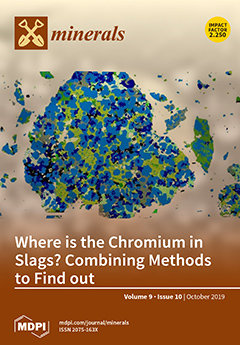The halophilic bacterium
Halomonas smyrnensis from a modern salt lake used in experiments to induce biomineralization has resulted in the precipitation of monohydrocalcite and other carbonate minerals. In this study, a
Halomonas smyrnensis WMS-3 (GenBank:MH425323) strain was identified based on 16S rDNA homology comparison, and then cultured in mediums with 3% NaCl concentration to induce monohydrocalcite at different Mg/Ca molar ratios of 0, 2, 5, 7, and 9. The growth curve of WMS-3 bacteria, pH values, NH
4+ concentration, HCO
3− and CO
32− concentration, carbonic anhydrase (CA) activity, and the changes in Ca
2+ and Mg
2+ ion concentration were determined to further explore the extracellular biomineralization mechanism. Moreover, the nucleation mechanism of monohydrocalcite on extracellular polymeric substances (EPS) was analyzed through studying ultrathin slices of the WMS-3 strain by High resolution transmission electron microscopy (HRTEM), Selected area election diffraction (SAED), Scanning transmission electron microscopy (STEM), and elemental mapping, besides this, amino acids in the EPS were also analyzed. The results show that pH increased to about 9.0 under the influence of ammonia and CA activity. The precipitation ratio (%, the ratio of the mass/volume concentration) of the Ca
2+ ion was 64.32%, 62.20%, 60.22%, 59.57%, and 54.42% at Mg/Ca molar ratios of 0, 2, 5, 7, and 9, respectively, on the 21st day of the experiments, and 6.69%, 7.10%, 7.74%, 8.09% for the Mg
2+ ion concentration at Mg/Ca molar ratios 2, 5, 7, and 9, respectively. The obtained minerals were calcite, Mg-rich calcite, aragonite, and hydromagnesite, in addition to the monohydrocalcite, as identified by X-ray diffraction (XRD) analyses. Monohydrocalcite had higher crystallinity when the Mg/Ca ratio increased from 7 to 9; thus, the stability of monohydrocalcite increased, also proven by the thermogravimetry (TG), derivative thermogravimetry (DTG) and differential scanning calorimetry (DSC) analyses. The C=O and C–O–C organic functional groups present in/on the minerals analyzed by Fourier transform infrared spectroscopy (FTIR), the various morphologies and the existence of P and S determined by scanning electron microscope-energy dispersive spectrometer (SEM-EDS), the relatively more negative stable carbon isotope values (−16.91‰ to −17.91‰) analyzed by a carbon isotope laser spectrometer, plus the typical surface chemistry by XPS, all support the biogenesis of these mineral precipitates. Moreover, Ca
2+ ions were able to enter the bacterial cell to induce intracellular biomineralization. This study is useful to understand the mechanism of biomineralization further and may provide theoretical reference concerning the formation of monohydrocalcite in nature.
Full article





